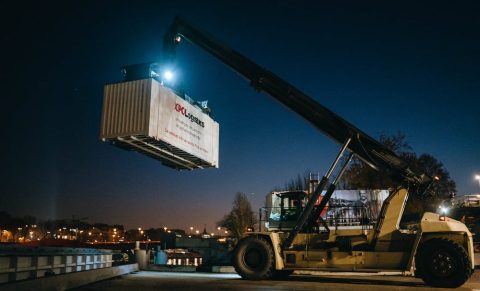Vertical loading most competitive for non-cranable trailers by rail

For the transhipment of non-cranable trailers to rail, a range of techniques are competing in terms of efficiency and cost, but new research by the EU has now provided valuable comparison of practises. Standard vertical transhipment technologies (gantry crane/reach stacker) remain the cheapest technology, and in combination with containers become competitive with road-only transport at distances of around 1000 kilometres, it concludes.
These findings were published by the EU Commission’s Directorate-General for Mobility and Transport (DG MOVE) as part of its strategy to drive more competitive intermodal transport and terminal capacity on the Trans-European Transport Network (TEN-T) network.
For the study, the researchers investigated a range of intermodal loading units, distinguishing between containers, swap bodies, semi-trailers, road trains, articulated vehicles and single road vehicles. “The study sheds light on which combinations are most used, how cost- and time efficient and available they are and what is their future potential. The study also analyses the available capacity and limitations of terminals on the TEN-T network,” a spokesperson for the Directorate-General explains.
Growth market
The market for non-cranable trailer transhipment has historically been limited in the rail sector by a lack of facilities to lift units onto trains, but changes to the sector and new technologies in recent years are steadily creating new opportunities for rail freight operators.
“When looking through the lens of environmental performance, already at 600km most intermodal transport chains would have lower external costs than road-only transport,” the authors add. Focusing on rail technologies alone, the ContainerMover technology with 20’ containers displayed the lowest overall comparative costs but suffered from a lower maximum transhipment weight.
The findings also suggest that across all the different modes of transport, short-sea shipping (SSS) still offers the lowest comparative costs per loading unit with rail being second and Inland waterways (IWW) offering the highest comparative costs for all six technology and loading unit combinations used on all modes of transport.
7.7 billion euros investment required
Given current projections however the report’s authors predict transhipment capacity will be insufficient by the end of this decade, requiring “further investments and careful planning”, to ensure that compatible transhipment solutions are available at rail terminals. The findings show that some 60 to 80 per cent of transhipment capacity in the EU currently comes from vertical transhipment technologies, followed by RoRo ships, which account for 20 to 35 per cent, with only around 2 per cent of transhipment capacity from other technologies.
As a result, the report’s authors forecast that major structural upgrades will be necessary on rail freight routes to allow sufficient transport of semitrailers by train, with the majority of these upgrades required in Spain, France and Italy.
“The required investment for the removal of these network limitations, loading gauge for semi-trailers, terminals with specific technology, is assessed being about €7.7 billion according to the medium range scenario,’ the report’s authors conclude.
You just read one of our premium articles free of charge
Want full access? Take advantage of our exclusive offer




